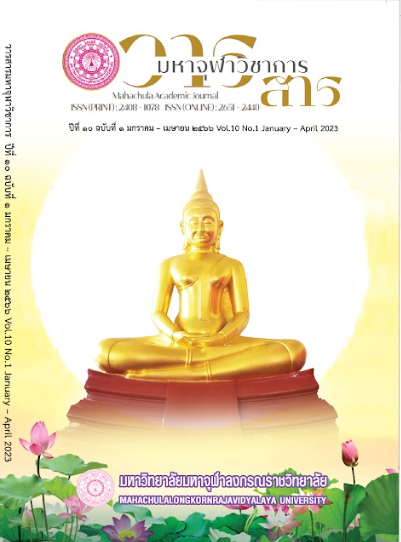Taxonomy of educational learning resources in Bangkok Metropolitan Administration
Main Article Content
Abstract
The objectives of this research were (1) to know the educational learning resources of Bangkok (2) to know the taxonomy of educational learning resources of Bangkok (3) to know the application of Bangkok's educational learning resources to use in academic administration in educational institutions. The research instrument were (1) Record form (2) Checklist form and (3) An open-ended questionnaire. The statistics used to analyze the data are frequency , percentage and content analysis.
The research findings revealed that: (1) There are 566 educational learning resources in Bangkok. When considering each district office, it was found that the district office with the most educational learning resources was Phra Nakhon District Office, 51 sources, followed by 37 Thonburi District Offices, and the least is Lat Phrao District Office Khan Na Yao District Office and Thawi Watthana District Office, 2 sources. ( 2) Educational learning resources of Bangkok can be classified according to the type of learning resources into 3 types: 1) There are 487 learning sources of building, places and man made structures consist of religious sites, museums, libraries, art galleries, historical sites, monuments, youth centers/stadiums, markets, bridges and other structures. 2) There are 38 learning resources in nature and environment consist of parks and gardens/farms/fields/nature and 3) There are 41 learning resources for individuals and communities. (3) The director of the educational institute is of the opinion that the process of utilizing Bangkok’s educational learning resources for academic administration in educational institutions is as follows : 1) The planning is carried out by ; raising awareness and mutual understanding; appointing the academic management committee; determine policies for development and use of educational learning resources; preparation of educational institutions; to create understanding among personnel and communities. 2) Implementation are carried out by appointing a committee responsible for learning resources; designating educational learning resources and providing information about learning resources; apply learning resources; teacher development; there is always coordination. 3) Audit, review, supervision, and follow-up are carried out by continuous supervision, monitoring and evaluation of the use of learning resources; resolving obstacles during the implementation process; determining methods and tools for evaluating performance; analyze the results of the assessment and summarize the results of the assessment. and 4) The summary and reporting are carried out by summarizing and reporting on the use of educational resources; revising, improving or developing work.
Article Details

This work is licensed under a Creative Commons Attribution-NonCommercial-NoDerivatives 4.0 International License.
References
กระทรวงศึกษาธิการ. แนวทางการจัดการเรียนรู้ตามหลักสูตรแกนกลางทางการศึกษาขึ้นพื้นฐาน พุทธศักราช ๒๕๕๑. กรุงเทพมหานคร: กระทรวงศึกษาธิการ, ๒๕๕๓.
กระทรวงศึกษาธิการ. สำนักงานเลขาธิการสภาการศึกษา. แผนการศึกษาแห่งชาติ พ.ศ. ๒๕๖๐-๒๕๗๙. กรุงเทพมหานคร: พริกหวานกราฟฟิค, ๒๕๖๐.
__________. รายงานการวิจัยประเมินผลการศึกษาขององค์กรปกครองส่วนท้องถิ่น. กรุงเทพมหานคร: พริกหวานกราฟฟิก, ๒๕๕๔.
จินดา โพธิ์อุบล. “แนวทางการดำเนินงานการใช้แหล่งเรียนรู้ในท้องถิ่น ของโรงเรียนในสังกัดเทศบาลเมืองชุมแสง อำเภอชุมแสง จังหวัดนครสวรรค์”. วิทยานิพนธ์มหาบัณฑิต. สาขาการบริหารการศึกษา มหาวิทยาลัยราชภัฏนครสวรรค์, ๒๕๕๙.
เบญจวรรณ นามะขันธ์. “แนวทางการบริหารแหล่งเรียนรู้ของสถานศึกษา สังกัดสำนักงานเขตพื้นที่การศึกษาประถมศึกษาเพชรบูรณ์ เขต ๓”. วิทยานิพนธ์หลักสูตรครุศาสตรมหาบัณฑิต. สาขาวิชาการบริหารการศึกษา มหาวิทยาลัยราชภัฏนครสวรรค์, ๒๕๖๓.
พระราชบัญญัติการศึกษาแห่งชาติ พ.ศ. ๒๕๔๒ แก้ไขเพิ่มเติม (ฉบับ ๒) พ.ศ. ๒๕๔๕ และ (ฉบับที่ ๓) พ.ศ. ๒๕๕๓, ราชกิจานุเบกษา เล่ม ๑๑๖, ตอนที่ ๗๔ ก (๑๙ สิงหาคม ๒๕๔๒) : ๑.
พิชัย เรืองดี. “การศึกษาแนวทางการบริหารแหล่งเรียนรู้ภายในสถานศึกษา สังกัดสำนักงานเขตพื้นที่การศึกษาประถมศึกษานครราชสีมา เขต ๕”. วิทยานิพนธ์มหาบัณฑิต. สาขาวิชาการบริหารการศึกษา มหาวิทยาลัยราชภัฏนครราชสีมา, ๒๕๕๘.
รชพรรณ ฆารพันธ์. “รูปแบบการพัฒนาแหล่งเรียนรู้ทางวัฒนธรรมโดยการมีส่วนร่วมของชุมชน ตำบลนาข่า อำเภอวาปีปทุม จังหวัดมหาสารคาม”. ดุษฎีนิพนธ์ปรัชญาดุษฎีบัณฑิต. สาขาวิชาวัฒนธรรมศาสตร์ มหาวิทยาลัยมหาสารคาม, ๒๕๕๘.
สาคร มหาหิงค์. “การบริหารแหล่งเรียนรู้ของสถานศึกษาขั้นพื้นฐาน สังกัดสำนักงานเขตพื้นที่การศึกษาประถมศึกษาขอนแก่น เขต ๔”. วารสารวิชาการแพรวากาฬสินธุ์ มหาวิทยาลัยกาฬสินธุ์. ปีที่ ๔ ฉบับที่ ๓ (กันยายน – ธันวาคม ๒๕๖๐) : ๕๗๔.
สุภานี นวกุล และคณะ. “การเพิ่มมูลค่าทางวัฒนธรรมและภูมิปัญญาท้องถิ่นผ่านระบบการจัดการแหล่งเรียนรู้และภูมิปัญญาท้องถิ่นในการอนุรักษ์ทรัพยากรธรรมชาติและสิ่งแวดล้อม : กรณีศึกษาเครือข่ายชุมชนเขาราวเทียนทอง จังหวัดชัยนาท”. รายงานวิจัย. คณะมนุษยศาสตร์และสังคมศาสตร์ สถาบันวิจัยและพัฒนา มหาวิทยาลัยราชภัฏจันทรเกษม, ๒๕๖๐.
นิรมล เสรีสกุล, อดิศักดิ์ กันทะเมืองลี้ และพรรณปพร. กรุงเทพฯ สู่มหานครแห่งการเรียนรู้. [ออนไลน์]. แหล่งที่มา: https://theurbanis.com/insight/๐๙/๐๔/๒๐๒๑/๔๔๓๑ [๑๐ สิงหาคม ๒๕๖๔].


